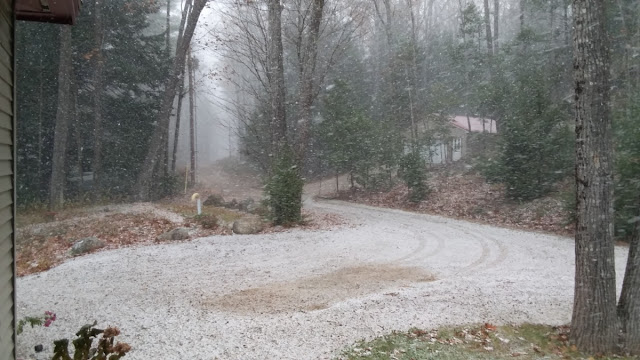We finally had our first visit from Jack Frost this week.
 |
| Ice formations on a window facing the water |
 |
| Fractal geometry on display |
The first hard freeze of the season occurred November 9th, when the temperature dropped to 24 degrees, covering everything with hoarfrost.
 |
| Red or brown, nature is an equal-opportunity employer |
Hoarfrost ("hoar" coming from the old English word for "old", presumably because it makes its host look old and gray) forms when humid air comes in contact with an object whose temperature is below the freezing point, thus changing from a vapor to a solid without passing through the liquid phase. It most often occurs in calm air and is common in the Lakes Region this time of year as warm lakes provide the needed moisture before they freeze over.
 |
| Hoarfrost on goldenrod |
Water vapor molecules first nucleate directly on an object and then grow, sometimes into long crystalline formations.
 |
| These ice crystals grew all night, fed by moisture from the lake |
It was late for the first frost, so I looked up the average first-frost date - data for Plymouth was the closest I could find - and the average date there is October 1st. (This means 50% of the time a frost occurs before that date. Scientists track multiple frost definitions, the one I'm quoting is for a temperature of 28 degrees; the 32 degree definition occurs about two weeks earlier.) Meredith is south of Plymouth and moderated by lakes, but even down in Concord the average date is October 3rd, so any way we look at it, we were well over a month later than average.
When Jack did finally arrive, he made his presence known, bringing with him strong squalls on Friday with a touch of snow.
He even caught the birds by surprise as they paddled around the lake trying to find a protected spot in which to hide.
 |
| There are ducks hidden in there somewhere |
With temperatures well below freezing (it was 18 degrees on Saturday morning) and the strong wind churning up the lakes, I expect water temperatures in New Hampshire lakes have dropped dramatically.
 |
| Windswept water froze onto overhanging branches |
Jack even painted the first skim of ice on the lake in protected coves and marshes.
 |
| More fractal patterns on the surface of the lake |
After a long hiatus, I did see one deer this week - just a glimpse, no photo.... I also saw signs of a buck in the neighborhood: bark worn off an aspen tree where the deer rubbed its antlers on the trunk.
 |
| Deer rub in the Hamlin Conservation Area |
Bucks do this to mark their territory, their antlers placing a scent on the tree, telling both male and female deer that he owns this area. Its presence here shows the value of clearings like this to wildlife in an area where much of the terrain is mature forest. You can easily find this rub if you want to see it: it is right beside the yellow trail in the clearing where the trail splits in two to head up to Crockett's Ledge. You can see the trail sign at the fork in this picture for reference.
 |
| This deer rub is easy to find |
Maybe the hunters will have some snow for tracking this year; it seems like Jack may have decided to stick around now for the season.
Answer to the location of the Meredith Rose from
two weeks ago: It is located on Main Street beside the Meredith Historical Society, across Highland Street from Town Hall.















The last picture of the sunlit frost on the trees against the dark background is gorgeous!
ReplyDelete